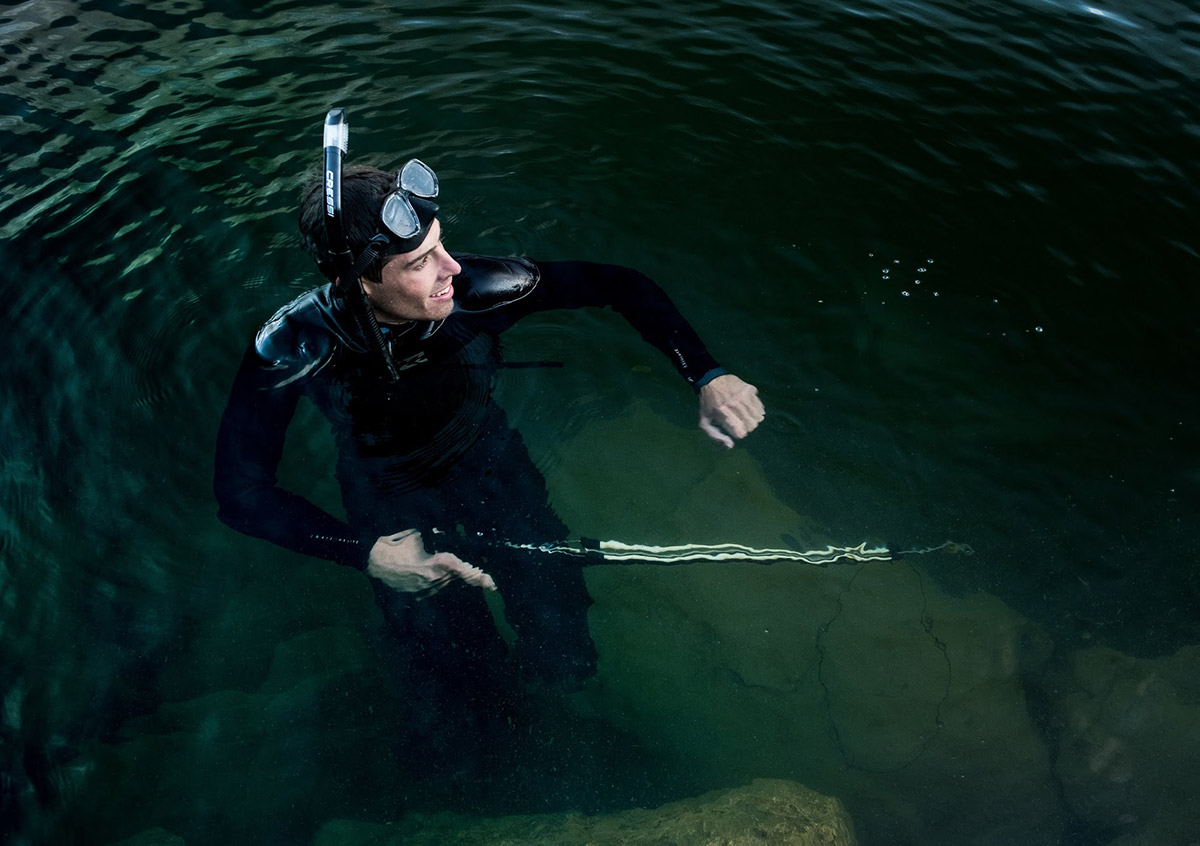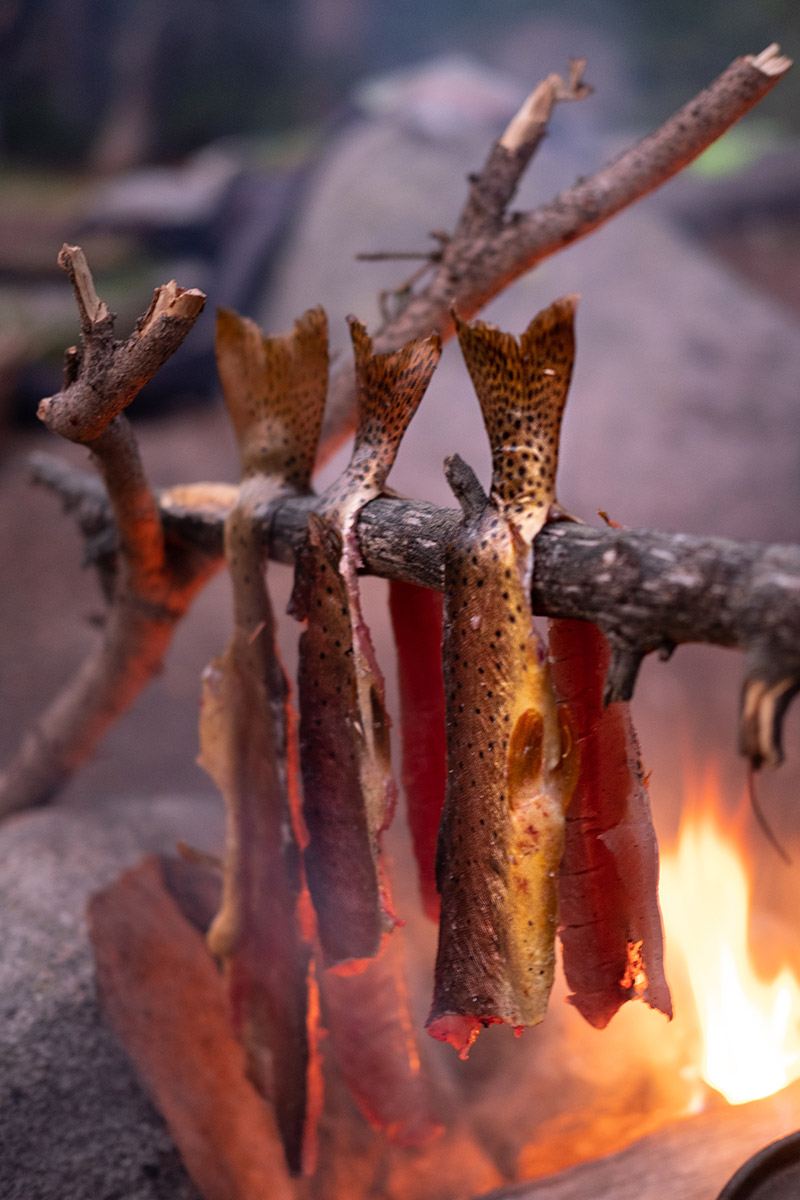
The pre-sunrise darkness condemned me to my truck. Bored and eager to fish, I picked up the only entertainment in my vicinity, a Wyoming fishing regulations pamphlet. I aimlessly thumbed through pages before stumbling onto a section titled “Underwater Spear Gun Fishing.” The coffee-stained paper read, “No person shall use an underwater spear gun to take game fish under water without obtaining a fishing license.” This one legalistic sentence would send me on a multi-year journey through several mountain ranges and countless miles of backcountry trails.
The fishing was subpar that day, and I couldn’t shake the notion of dipping into the water and taking the fight to the trout instead of passively waiting for a bite. On my way home, I decided to confirm the legality of stabbing prized trout with sharp objects. At the WGFD office, a cowboy hat wearing warden, astonished and possibly humored by my interest in spear fishing, confirmed that shooting a trout with a spear is, in fact, legal.
My spearfishing was limited, to say the least, but my interest was decidedly piqued. I’d never even heard of anyone spearing for trout. Unfortunately, my timing was off. With fall weather turning, Wyoming would soon be consumed by a cruel winter, putting the kibosh on any immediate spearing ambitions.
Winter gave me plenty of time to scheme and consider the ethics of my intentions. Driving to a local lake, squeezing into a wetsuit, and swimming out toward a popular trout spot seemed dull and intrusive toward other fishermen. It also carried the possibility of being prop-chopped like a Florida manatee or possibly getting my ass kicked in the parking lot. I was also concerned with killing the beautiful, native trout that I usually release after catching.
One afternoon while tying flies, alpine possibilities crossed my mind. I made countless trips to high-elevation lakes every summer with a fly rod. Why not ditch the rod for a spear? This revelation also helped with the catch-and-release dilemma. The fish that live in our high mountain lakes are not native, typically planted by cowboys and biologists of the 20th century trying to create recreational opportunities for the locals.
Alpine lakes seemed a viable solution—mountain ranges spread across Wyoming, showcasing chiseled peaks and vertical rock walls that drop into glacier-fed lakes—but a couple problems remained. Water clarity in these lakes varies, some murky, others so clear and vibrant they could be confused with the Caribbean. The clarity of glacial lakes depends on sediment loads, stream flows, and temperature. After years visiting these lakes, I have come to find a long hike is the only accurate method for surveying clarity.
Additionally, my window would be short. Depending on summer temperatures, the thick ice shields that cover these lakes most of the year won’t begin to melt until June and can linger into August. They will frequently ice-up again in October, leaving me just three or four months to carry out my farfetched plans.
July of 2018 provided my first opportunity. The dive mask pinched at my hairline as I slipped into the water, and my goggles fogged immediately upon transferring from the summer air to the frigid water. Following the old tradition of de-fogging a mask, I spit a mouthful of saliva onto the lenses and wiped them clear. Still, I strained to find the end of my spear underwater. Silt percolating from the scree field above ended any hope of spearing a trout that day. In addition, my buoyancy was far from neutral. The thick, hooded wetsuit made me float like a cork, requiring me to waste precious energy diving down. I needed a weight belt, and found that two, 4-pound weights worked well. Obviously, these were a nuisance to carry into remote regions, but after a quick trial, I realized the benefits. With practice, I was able to control my depth with my breathing. An exhale through my snorkel meant a steady descent, while full lungs kept me floating at the surface.
Unfortunately, however, not a single trout succumbed to a metal point that summer, and I spent the winter starring at a virgin speargun leaning against the wall.
In June of 2019, I set out for northwest Wyoming where one of the nation’s deepest lakes reaches depths of a staggering 600 feet. I guessed the sheer size of this lake would allow debris to settle. After slipping in, I found I could see 30 feet in any direction without issue. The fish also benefitted from this transparency, spotting me from great distances and immediately fleeing to the darkness below. As frustrating as the finicky fish were, I was able to finally take some shots. Groups of 12-inch rainbows would occasionally swarm my position, interested in the alien creature. They teased me, coming just shy of my effective range—about 5 feet. Any further and the trout appeared to be faster than my spear. I would need to be close and the spear needed to be aimed at the head to account for a quick flight, ideally meeting the trout’s body as it swam forward.
Later in the summer, accompanied by a friend and my brother, I set my sights on two lakes rarely visited by people. They were not large in size or depth, but appeared from photos to be clear enough for diving. The dual lakes were 7 miles back in a central Wyoming mountain range, hidden in a large bowl by steep cliffs. We arrived at one of the two lakes late in the afternoon and immediately put on our wetsuits. Conditions were perfect. The water depth averaged about 8 feet, meaning the trout couldn’t dive out of range. It was clear enough to see everything, but not clear enough to see from great distances. We swam the edge, hovering over dead trees and boulders that had fallen from the rock walls above. In the periphery of my mask, I spotted a lone trout feet from my position. I turned the spear in its direction, and it swam off in a hurry. The water that had leaked into my wetsuit wasn’t even warm from my body heat, and I was already getting prospects! The best part: I had three more days of spearing ahead.
Minutes later, we spotted another trout. It stared at me, motionless, likely hoping I hadn’t seen it. With a slow kick of my fin I drifted in its direction, innocently raising my spear toward his head. I squeezed the trigger and in an explosion of rubber and metal my two-year journey was over. Pinned to the lake bed, 10,000 feet above sea level, rested a 16-inch Yellowstone cutthroat trout. The snorkel fell from my mouth and I inhaled water swimming down to the fish. My hand clutched the trout and I swung it above the surface, yelling and coughing to my brother on the bank, “I got one! I got one!” I had been in the water for less than 15 minutes.
We spent two days camped near the lake. Fish were plentiful and all three of us speared trout. We became selective in the fish we targeted, taking only seven fish between the three of us over the entire trip. We gutted and hung them over the fire to dry using a native Alaskan method. The water temperature was still as unforgiving as my previous experiences, capping our diving time at about 40 minutes before uncontrollable shivering took over, but the excitement of the hunt made the temperatures manageable. When we couldn’t handle the ice bath any longer, we traded out the spear guns for shotguns. Grouse were plentiful in the surrounding forests and we harvested three blues. We stripped the meat from the birds and put it in our packs next to the dried trout. With plenty of food, we trekked out of the mountains toward the trailhead, blown away with the outcome.
Despite how much fun we had, I doubt the Cowboy State will ever become a spear fishing mecca. High alpine spearing certainly isn’t for everyone; there’s a degree of brutality to it that would dissuade fair-water divers. Clarity, weather, and ice dictate opportunity and, subsequently, the prospects of success. But, with planning and practice, the reward comes in the form of a large trout, dwarfed by the surrounding mountains in an oxygen deprived paradise. And of course, a genuine, original adventure.
Images via Derek Collins.







